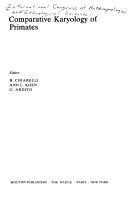| Listing 1 - 2 of 2 |
Sort by
|

ISBN: 9781139427081 1280416726 0511173873 0511039433 0511153139 0511303378 0511542364 0511052790 9780511052798 9780511173875 9780521451604 0521451604 9780511039430 0521451604 9780511303371 9780511542367 9780521123853 0521123852 1107112184 Year: 2000 Publisher: Cambridge, U.K. New York : Cambridge University Press,
Abstract | Keywords | Export | Availability | Bookmark
 Loading...
Loading...Choose an application
- Reference Manager
- EndNote
- RefWorks (Direct export to RefWorks)
Human Paleobiology provides a unifying framework for the study of human populations, both past and present, to a range of changing environments. It integrates evidence from studies of human adaptability, comparative primatology, and molecular genetics to document consistent measures of genetic distance between subspecies, species and other taxonomic groupings. These findings support the interpretation of the biology of humans in terms of a smaller number of populations characterised by higher levels of genetic continuity than previously hypothesised. Using this as a basis, Robert Eckhardt then goes on to analyse problems in human paleobiology including phenotypic differentiation, patterns of species range expansion and phyletic succession in terms of the patterns and processes still observable in extant populations. This book will be a challenging and stimulating read for students and researchers interested in human paleobiology or evolutionary anthropology.
Physical anthropology. --- Paleobiology. --- Human evolution. --- Fossil hominids. --- Early man --- Fossil hominins --- Fossil man --- Hominids, Fossil --- Hominins, Fossil --- Human fossils --- Human remains (Archaeology) --- Primates, Fossil --- Paleoanthropology --- Evolution (Biology) --- Physical anthropology --- Evolutionary psychology --- Human beings --- Palaeobiology --- Biology --- Paleontology --- Biological anthropology --- Somatology --- Anthropology --- Human biology --- Origin --- Evolution --- Anthropologie physique --- Paléobiologie --- Homme --- Homme fossile


ISBN: 9027978506 3110802635 9783110802634 130627222X 9781306272223 9789027978509 0202900657 9780202900650 Year: 2011 Publisher: Berlin Boston
Abstract | Keywords | Export | Availability | Bookmark
 Loading...
Loading...Choose an application
- Reference Manager
- EndNote
- RefWorks (Direct export to RefWorks)
No detailed description available for "Comparative Karyology of Primates".
Neurophysiology. --- Karyotypes --- Chromosomes --- Chromosome abnormalities --- Cytotaxonomy --- Genetics --- Neurophysiology
| Listing 1 - 2 of 2 |
Sort by
|

 Search
Search Feedback
Feedback About UniCat
About UniCat  Help
Help News
News